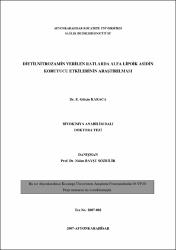Dietilnitrozamin Verilen Ratlarda Alfa Lipoik Asidin Koruyucu Etkilerinin Araştırılması
Abstract
Çalışmada, dietilnitrozaminin karaciğer üzerindeki toksik etkilerinin belirlenmesi ve bu toksik
etkilere bağlı olarak meydana gelebilecek oksidatif strese karsı -lipoik asidin koruyucu
etkisinin araştırılması amaçlanmıştır.
Materyal olarak yaklaşık 3 aylık ve 260±10.5 gr olan 49 adet Sprague- Dawley cinsi erkek
rat kullanılmıştır. Ratlar; grup1(kontrol), grup 2 (periton içi tek doz 150 mg/kg
dietilnitrozamin verilmiş), grup 3 (periton içi tek doz 150 mg/kg dietilnitrozamin ile oral
gavajla 14 gün 2 cc/gün zeytinyağı verilmiş), grup 4 (periton içi tek doz 150 mg/kg
dietilnitrozamin ile oral gavajla 7 gün 100 mg/kg/gün -lipoik asit 2 cc zeytinyağında
çözdürülerek verilmiş), grup 5 (periton içi tek doz 150 mg/kg dietilnitrozamin ile oral gavajla
14 gün 100 mg/kg/gün - lipoik asit 2 cc zeytinyağında çözdürülerek verilmiş), grup 6 (oral
gavajla 14 gün 100 mg/kg/gün -lipoik asit 2 cc zeytinyağında çözdürülerek verilmiş) ve grup
7 (oral gavajla 14 gün 2 cc/gün zeytinyağı verilmiş) olmak üzere yedi eşit gruba ayrılmıştır.
On beş gün süren uygulamanın sonunda anestezi altında kalplerinden heparinli tüplere kan
örnekleri alınmıştır. Alınan kan örneklerinden bir miktarı tam kan olarak ayrılmıştır.Geriye
kalan kanlar santrifüj yapılarak serumları elde edilmiştir. Tam kanlarda GSH ve MDA
tayinleri, serumlarda AST, ALT, GGT, ALP ve ADA tayinleri yapılmıştır.
Dietilnitrozamin verilen gruplarda kontrol grubuna göre GSH düzeylerinde belirgin düşme,
MDA, AST, ALT, GGT, ALP ve ADA düzeylerinde belirgin yükselme tespit edilmiştir.
Dietilnitrozamin ile beraber -lipoik asit verilen gruplarda GSH düzeylerinde yükselme,
MDA, AST, ALT, GGT, ALP ve ADA düzeylerinde düşme tespit edilmiştir. Lipoik asidin
hem 7 gün hem de 14 gün verilmesinin koruyucu olduğu, ancak 14 gün kullanımının 7 gün
kullanımına göre daha etkili olduğu tespit edilmiştir.
Sonuç olarak dietilnitrozaminin toksik etkilerine bağlı olarak oksidatif stresi arttırabileceği,
-lipoik asidin ise meydana gelen bu strese karsı lipid peroksidasyonunu önleyerek, redükte
glutatyon gibi antioksidan moleküllerin miktarını arttırarak ve bir serbest radikal temizleyicisi
gibi rol oynayarak koruyucu etki yapabileceği kanaatine varılmıştır. Buna dayanarak alkol,
nonsteroid antiinflamatuar ilaçlar, ağır metal zehirlenmeleri, viral hepatitler ve kanser gibi
nedenlerle meydana gelmiş olan karaciğer hasarlarında tedavi amacıyla kullanılabileceği
düşünülmektedir. Ayrıca, ilaçların pek çoğu karaciğerden metabolize olduğundan uzun süre
ilaç kullanılması gereken kronik hastalıklarda da koruyucu amaçlı olarak verilmesinin uygun
olabileceği kanaatine varılmıştır. This study aimed to determine toxic effects of diethylnitrosamine on liver and to investigate
the protective effect of -lipoic acid to oxidative stres related with the toxic effects of
diethylnitrosamine.
As material, nearly 3 month old 260±10.5 gr, 49 Spraque-Dawley kind male rats have been
used. The rats were equally divided into seven groups, group 1 (control), group 2
(intraperitoneally one dose of 150 mg/kg diethylnitrosamine has been given), group 3
(intraperitoneally one dose of 150 mg/kg diethylnitrosamine and 2 cc. olive oil with oral
gavaj from 14 days has been given), group 4 (intraperitoneally one dose of 150 mg/kg
diethylnitrosamine and with oral gavaj 100 mg/kg/day -lipoic acid by solving it in 2 cc. olive
oil for 7 days has been given), group 5 (intraperitoneally one dose of 150 mg/kg
diethylnitrosamine and with oral gavaj 100 mg/kg/day -lipoic acid by solving it in 2 cc.
olive oil for 14 days has been given), group 6 ( with oral gavaj 100 mg/kg/day -lipoic acid
by solving it in 2 cc. olive oil for 14 days has been given)and group 7 (with oral gavaj 2 cc.
olive oil for 14 days has been given each day). At the end of the 15 days study ınder
anesthesia, blood samples were taken from their hearts which anesthesia to the heparin tubes.
Some quantity of the blood samples were kept as whole blood. The rest of the blood were
centrifugal, and their serums were gained. In the whole blood, GSH and MDA classifications,
in the serums AST,ALT, GGT,ALP and ADA classifications have been conducted.
Compared to the control group, in the group given diethylnitrosamine a considerable
decrease has been identified in the GSH level and the considerable increase in MDA, AST,
ALT, GGT, ALP and ADA levels have been identified. It is identified that giving - lipoic
acid for both 7 and 14 days are protective, but 14 days of usage is more effective than 7 days
of usage.
As a result it has been deducted that diethylnitrosamine depending on the toxic effects can
enhance the oxidative stres, but - lipoic acid prevents the lipid peroxidation occured against
the stress and increases the levels of antioxidan molecules, such as reduced glutathione
and it can make a protective effect and playing role like scavenging of free radicals. In terms
of this it is thought that it can be used to cure liver injuries because of alcohol, NSAI
medicines, heavy metal poisoning, viral hepatitis and cancer. Besides as most of the
medicines are metabolised from the liver, it is believed that it can be given as protector to the
chronic ilnesses that long-term medicines must be used.
Collections
- Doktora Tezleri [154]



















